An algorithm must be seen to be believed.
-- Donald Knuth
Previously,
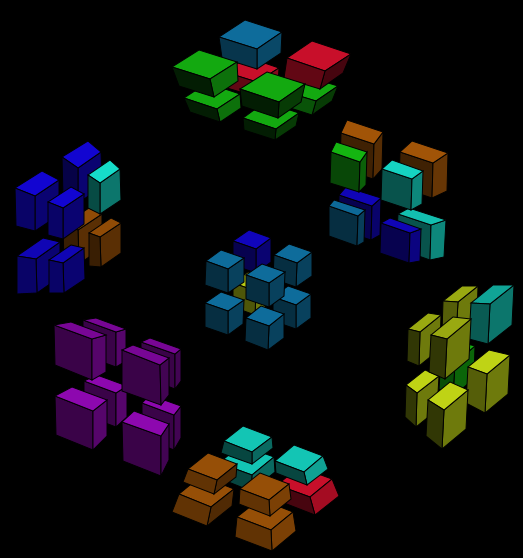
Or center the Y+,
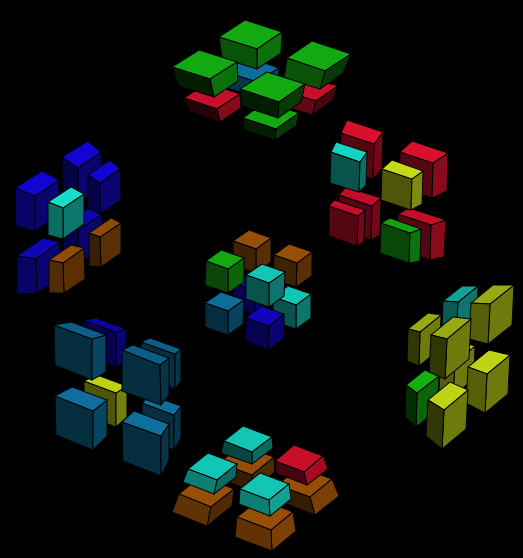
All W+ side of the stickers that we can see are settled neatly now.
Yes, we do need new tricks. It was not obvious before, but the algorithm we used for the 8th cubie cannot apply to the situation now for gray cell. A simple demonstration below,
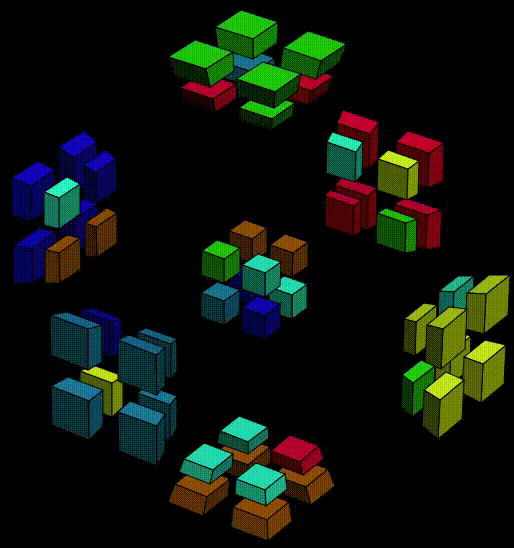
After the sequence, the pink cell is totally ruined. Unless we can control the mess, otherwise we cannot consider it as a tool to tackle the rest of the puzzle. Basically I will keep following the break-and-glue heuristic to develop further algorithms and hope that they can work for different situations.
Experienced readers would expect that I should bringup some OLL and PLL algorithms now. I am not sure for 2x2x2x2 if OLL should also go before PLL. Anyway, I will try to find something useful.
Wait, OLL, PLL? OK...
OLL stands for Orientation of the Last Layer and PLL stands for the Permutation of the Last Layer, where permutation is a cooler term than position. In an general solve of a Rubik's cube, people often finish the first two layers first, and than do OLL to change the orientations of specific cubies, such that after OLL phase the whole last face shows only the final color. Note however, other sides of the last-layer cubies are still a mess, so the final phase, PLL, sorts out the cubies, and the puzzle is done.
My favorite orientation algorithm when playing with 2x2x2 can be easily described. From a complete face, do a Y-axis-twist (R) so that one cubie goes into the last layer, do one 90 degree twist around Z-axis (U), and then resume the first twist (R'). The once-finished layer now contains a stranger cubie and its 4th cubie is at the last layer. Do 90 degree more around Z-axis (U) then move the 4th cubie back with 180 degree Z-axis twist (U2) following by one Y-axis twist (R') resuming the first layer. Give it one more 180 degree Z-axis twist (U2), the O0 and O3 (please allow me to apply this notation on a 2x2x2) changes their orientations as if they twist themselves in place while the other part of the cube remains still.
Basically we can apply the same technique in 2x2x2x2, especially where we are now. I will try two slightly different sequences below, and analyze what do they return.
Idea: similar to how we deal with the 8th cubie, we also go with a Z-axis-twist to X+ so that half of the pink stickerscome visible in Y-. Then, we move the Y-O0/W-O3 and Y-O7/W-O4 away, send the pink stickers in Y- back to W+, move the two pinks further, a Z-axis-twist to X+ to push the pink stickers our again, merge all the visible pinks again at Y-, and send then back to W+.
Move-away: 180 degree Y-axis-twist to W-
Move-further: 180 degree X-axis-twist to W-
Merge: 180 degree Z-axis-twist to W-
Check the clip,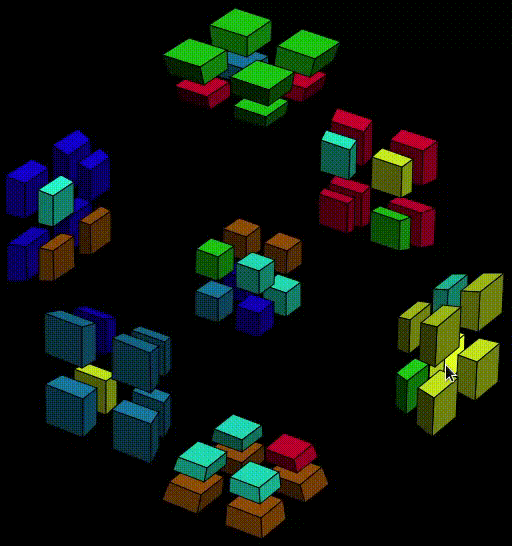
The sequence change the puzzle from this
to this,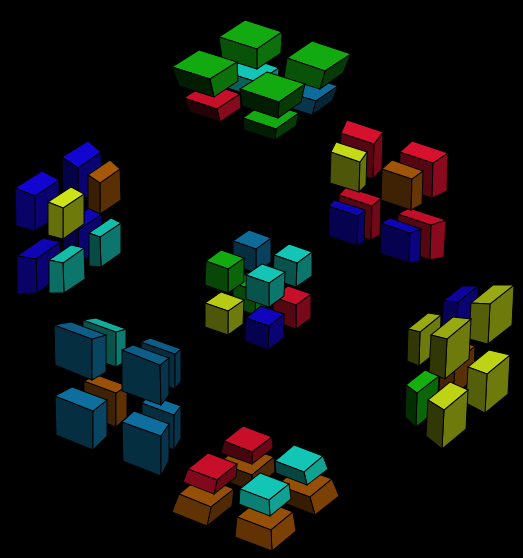
It is quite interesting because W-O4 and W-O5 remain unchanged for both position and orientation, but other six look very different. A deep dive analysis as below,
W-O0 was originally turquoise-yellow-red-orange, now goes to W-O5 as turquoise-orange-red-yellow
W-O1 was originally blue-turquoise-gray-orange, now goes to W-O0 as blue-orange-gray-turquoise
W-O5 was originally orange-yellow-turquoise-gray, now goes to W-O1 as orange-yellow-turquoise-gray
W-O2 was originally turquoise-blue-red-green, now goes to W-O6 as turquoise-blue-red-green
W-O6 was originally orange-red-turquoise-blue, now goes to W-O7 as orange-blue-turquoise-red
W-O7 was originally yellow-green-red-turquoise, now goes to W-O2 as yellow-turquoise-red-green
W-O3/W-O4 remain unchanged
This is not a pure OLL because permutations of the cubies also change. Here we can see two groups of 3-cycle. Not only that, the orientation effect is more complicated than 3D. (1) For cubie W-O0/O1/O6/O7, the sticker of the last layer (W-) can change, and (2) even if the sticker of the last layer remains the same and the cubie stays at the same position, the cubie can still have different (other 2) orientations.
This is not particularly useful because too many cubies changes due to this sequence. Let's try the other one.
Move-away: 90 degree clockwise Z-axis-twist to W-
Move-further: 90 degree Z-axis-twist to W-
Merge: 180 degree Z-axis-twist to W-
Check the clip,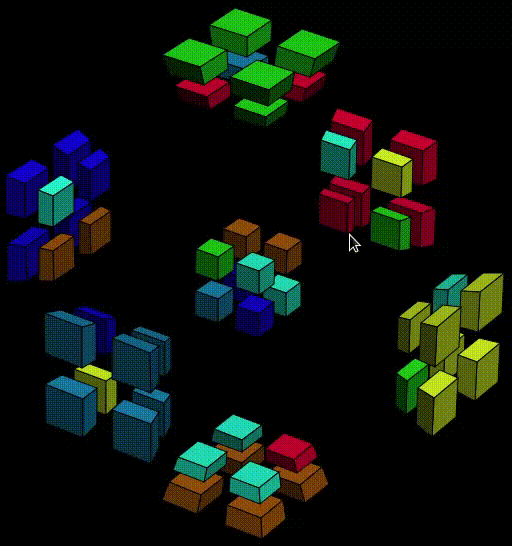
The sequence change the puzzle from this
to this,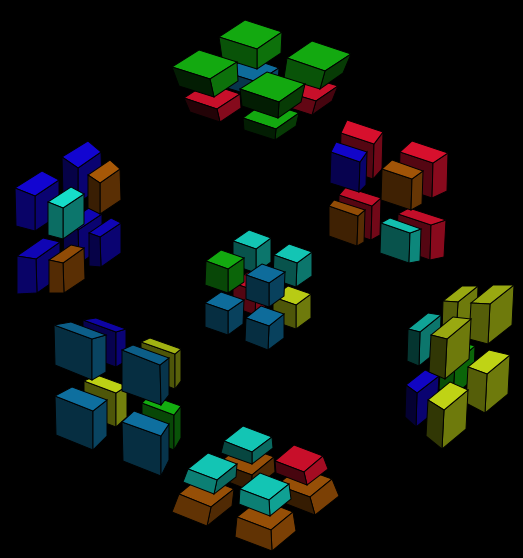
This one is cool because all cubies stay at their original position! Only orientation changes as follows,
W-O0 was originally turquoise-yellow-red-orange, now yellow-orange-red-turquoise
W-O7 was originally yellow-green-red-turquoise, now green-turquoise-red-yellow
W-O1 was originally blue-turquoise-gray-orange, now orange-blue-gray-turquoise
W-O6 was originally orange-red-turquoise-blue, now blue-orange-turquoise-red
W-O3 was originally yellow-gray-green-turquoise, now turquoise-yellow-green-gray
W-O4 was originally green-gray-turquoise-blue, now blue-green-turquoise-gray
W-O2/W-O5 remain unchanged
There is one thing in common. All cubies other than W-O2/O5, fix Z sticker after Algorithm 2, so X-Y-W stickers form 3-cycle orientation change. This is cool.
Imagine that we do the mirrored sequence, what will happen? For W-O0/O1/O6/O7, the orientation reverses. W-O3/O4 remain unchanged. W-O2/O5 rotate in the reverse direction of W-O3/O4 above. We can name this mirrored algorithm 2m. Algorithm 2 concatenate Algorithm 2m results in a new 3-cycle sequence, where the Y+ side of W- remains unchanged and the 4 cubies at the Y- side has rotation.
Here comes the Aha moment... we can do some setup before Algorithm 2m, so that W-O2/O5 still remain unchange after the whole sequence. The trick is a 180 Y-axis-twist to Y-. This setup moves W-O2/O5 to the unchanged position in the mirror, and also rotate W-O3/O4 again. Theoretically this is yet another 3-cycle for only W-O3 and W-O4, which is the most powerfull sequence we have discovered. Let's redefine this sequence as Algorithm 2M, whose 4 steps are
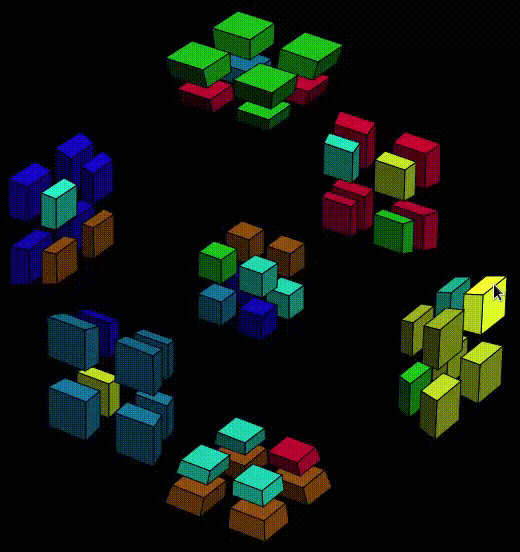
The sequence 2M change the puzzle from this
to this,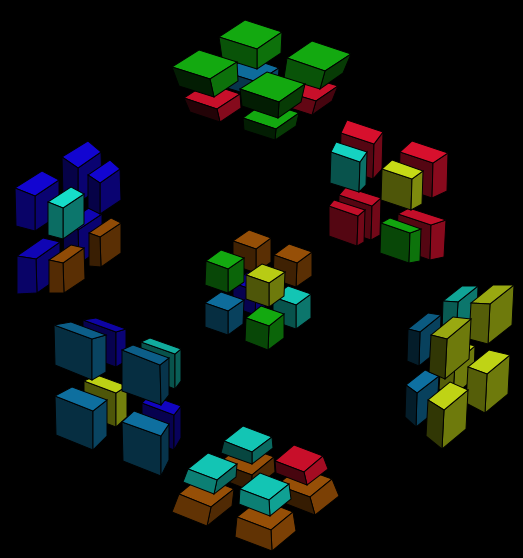
It seems like Algorithm 2M is a powerful sequence, but is it really useful? Tomorrow, let's try using it to gather all turquoise stickers at W-.
開發 OLL 公式,找到一個只轉動兩個方塊的公式。
